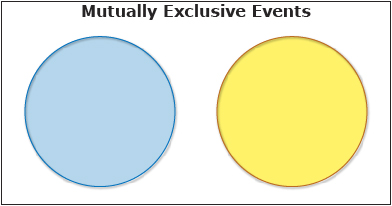Lesson 2
1. Lesson 2
1.5. Explore
Module 2: Probability
Explore

Zoonar/Thinkstock
In Discover, you used Sample Space of Rolling Two Dice and Venn diagrams to show the difference between events that have no common outcomes (set of rules for Game A) and events that have common outcomes (set of rules for Game B).
The set of rules for Game A only allowed Janek to move if either doubles were rolled or a sum of 7 was rolled. It would be impossible to roll doubles and a sum of 7 at the same time. When two events cannot occur at the same time, the events are said to be mutually exclusive.
The number of outcomes in the union of the two events is the sum of the outcomes in each event. This information can be summarized in the following diagram.

Mutually exclusive events do not share any common outcomes.
The set of rules for Game B only allowed Janek to move if he did one or the other of the following:
- rolled a sum greater than or equal to 10
- rolled a sum that is an even number
As you saw, both of these events can occur at the same time. For example, it is possible to roll a 6 and 6. The sum of 12 is both greater than 10 and is an even number. These events are considered non-mutually exclusive.

Non-mutually exclusive events share common outcomes. In the Venn diagram, the green area represents the common outcomes.
This diagram is used when one sees the word or and events from A and B can happen at the same time.
Try This 2
Create an example that is not used in this lesson to describe the difference between mutually exclusive and non-mutually exclusive events.
- Draw a Venn diagram that describes your example. Label the first event as Event A and the second as Event B.
- Indicate whether the example is mutually exclusive or non-mutually exclusive.
![]() Save your responses in your course folder.
Save your responses in your course folder.
Share 2
Share your example from Try This 2 with a partner or group. As you look at examples from other students, discuss the following.
- What similarities do you notice between Venn diagrams of the mutually exclusive examples?
- What similarities do you notice between Venn diagrams of the non-mutually exclusive examples?